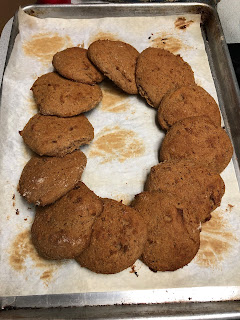 |
| Secale cereale (seeds visible and ready to fall out) |
 |
| unripe rye / closeup of spikelet pair |
Wheat and barley can look very similar to rye. Grasses are a botanical specialty of their own, and have a specialized language to describe all the parts, but I will try not use more commonly understandable descriptions here. They all have groups of seed-carrying structures (called spikelets), which are arranged in a fairly dense pattern at the top of the stem, attached directly to the stem (sessile), and alternating sides along the stem. They usually have long hairs (or awns) coming from each spikelet. Rye always has two seed-carrying spikelets side by side at each node along the stem, with two long awns. Barley has three spikelets at each node along the stem, although typically only one produces a large seed; but they have three awns each (nine awns per node) so barley has the most bearded appearance. Wheat has one spikelet per node, with several seeds packed in a dense cluster; typically three or so develop large seeds; and wheat may or may not have awns depending on the variety. One rule of thumb is that barley has one seed, rye has two, and wheat has three seeds. This is reliable for rye, but some varieties of barley have been bred which get all three spikelets to grow a large seed, and the number of seeds in a wheat spikelet is somewhat variable.
I picked my rye when they already looked fully ripe, as in they were turning yellow or straw colored, and some the spikelets were already falling off the tops. I tried to pull just the seed off the top, without the long stem below. Doing this one by one is a bit slow, but I enjoy wandering around the wilds, so I enjoy doing it. I collected from three different places, spending about an hour each day, and my three hours yielded a four gallon bucket nearly full of fluffy heads of rye.
Separating out the seeds turned out to be easier than I expected. The traditional ways turn out to be fairly efficient. There are two steps: threshing and winnowing. To thresh the grain, I put my rye into a cloth bag and beat it with a heavy stick for 10 or 15 minutes. Winnowing is done by pouring the grains between two buckets and letting the wind blow the chaff away, while the grains fall into the bucket. Ideally, you should use a fan to get a stiff, steady wind. But I don't currently own one, so I just used the natural breezes. Even a light breeze blows away the smaller bits of chaff, but I was having trouble separating the larger bits, so I did it again the next day when there was a little more wind. Personally, the dust from this process (mostly small bits of chaff) can be extremely irritating to my sinuses, so I definitely recommend doing all this outdoors where the dust will be blown away as soon as possible. After threshing and winnowing, my yield was about 4½ cups of grain. I have a nice hand grinder, and I've used it a lot in the past for wheat. Instead, I used the electric grinder to speed things up. After grinding I measured 7½ cups of flour, so grinding nearly doubled the volume.
 |
| 100% Rye Rolls |
 |
| Wheat/Rye Bread |
No comments:
Post a Comment